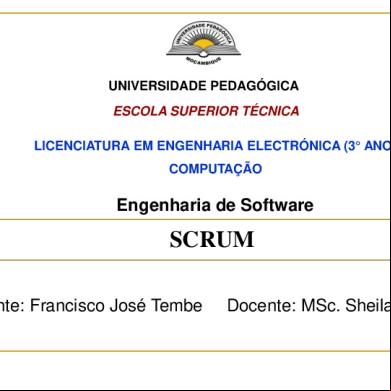Scrum Ppt 1zp1z
This document was ed by and they confirmed that they have the permission to share it. If you are author or own the copyright of this book, please report to us by using this report form. Report 3b7i
Overview 3e4r5l
& View Scrum Ppt as PDF for free.
More details w3441
- Words: 611
- Pages: 12
Scrum Methodology
What is Scrum
Scrum is an iterative and incremental agile software development framework for managing product development. It defines "a flexible, holistic product development strategy where a development team works as a unit to reach a common goal
History
Jeff Sutherland, John Scumniotales, and Jeff McKenna invented Scrum in 1993. And then there are others who vouch for Hirotaka Takeuchi and Ikujiro Nonaka as inventing Scrum in 1986.
Facts About Scrum
It is a Framework
Peoples has much importance in Scrum
Easily Change if changing required(Because changing is Natural)
Not much focus on documentation like other software Development methods
Not fixed plan (plan can be changed on meetings)
Why Scrum
The Scrum methodology of agile software development marks a dramatic departure from waterfall management. In fact, Scrum and other agile processes were inspired by its shortcomings. The Scrum methodology emphasizes communication and collaboration, functioning software, and the flexibility to adapt to emerging business realities — all attributes that suffer in the rigidly ordered waterfall paradigm.
Overview
Roles
Scrum Master
Product owner
Team
Sprint
Planning meeting
Development
Daily meeting
ScrumMaster: The ScrumMaster is responsible for making sure the team understands and follow the Scrum framework. He or she is also responsible to resolve all impediments which may arise
Product Owner The Product Owner represents the voice of the client. It means, he or she knows exactly what the client wants for the product to be developed. In a perfect world, the Product Owner would be the client him or herself, however in real life this is almost impossible.
Team The team is a set of people who develops the product. There are responsible for deg, implementing, testing and fixing bugs of the product being built. One may argue they are the ones who get the job done.
Sprint Sprint is basic unit of development. If you wish to add a new feature to the software, you would have to have to the next Sprint. Sprint encomes the following procedures of software development: planning, developing the product, daily meetings, a review to show a demo and a retrospective to discuss what is going well and what can be improved.
Planning Meeting This where the Sprint begins. The Product Owner, selects a list of features to be developed from the Product Backlog. The ones which are to be developed here are stored in the so-called Sprint Backlog. The Product Owner, presents these functionalities and their priorities along with the Sprint's Goal (explained in details later) to the Team, who agrees or not to develop all these activities, reaching the presented Goal for the current Sprint.
Development This is not exactly a phase, it is how the Team should behave during the Sprint development. After the tasks have been broken down and the whole Team is aware what is to be done, so the work starts.
Daily Meeting
Daily Meeting, as its name says, a meeting to be done everyday its 15min meeting, where each member of the Team has to answer the following questions: 1.
From the last Daily Meeting to this one, what have I done?
2.
What do I plan to do until the next Daily Meeting?
3.
Do I have any sort of impediment (any kind at all)?
Not use when
Scrum should not be used for small teams, up to three people. In this case, experience shows that the framework is not so useful for a few reasons. The of the Team probably talk to each other all the time, making Daily Meetings pointless.
What is Scrum
Scrum is an iterative and incremental agile software development framework for managing product development. It defines "a flexible, holistic product development strategy where a development team works as a unit to reach a common goal
History
Jeff Sutherland, John Scumniotales, and Jeff McKenna invented Scrum in 1993. And then there are others who vouch for Hirotaka Takeuchi and Ikujiro Nonaka as inventing Scrum in 1986.
Facts About Scrum
It is a Framework
Peoples has much importance in Scrum
Easily Change if changing required(Because changing is Natural)
Not much focus on documentation like other software Development methods
Not fixed plan (plan can be changed on meetings)
Why Scrum
The Scrum methodology of agile software development marks a dramatic departure from waterfall management. In fact, Scrum and other agile processes were inspired by its shortcomings. The Scrum methodology emphasizes communication and collaboration, functioning software, and the flexibility to adapt to emerging business realities — all attributes that suffer in the rigidly ordered waterfall paradigm.
Overview
Roles
Scrum Master
Product owner
Team
Sprint
Planning meeting
Development
Daily meeting
ScrumMaster: The ScrumMaster is responsible for making sure the team understands and follow the Scrum framework. He or she is also responsible to resolve all impediments which may arise
Product Owner The Product Owner represents the voice of the client. It means, he or she knows exactly what the client wants for the product to be developed. In a perfect world, the Product Owner would be the client him or herself, however in real life this is almost impossible.
Team The team is a set of people who develops the product. There are responsible for deg, implementing, testing and fixing bugs of the product being built. One may argue they are the ones who get the job done.
Sprint Sprint is basic unit of development. If you wish to add a new feature to the software, you would have to have to the next Sprint. Sprint encomes the following procedures of software development: planning, developing the product, daily meetings, a review to show a demo and a retrospective to discuss what is going well and what can be improved.
Planning Meeting This where the Sprint begins. The Product Owner, selects a list of features to be developed from the Product Backlog. The ones which are to be developed here are stored in the so-called Sprint Backlog. The Product Owner, presents these functionalities and their priorities along with the Sprint's Goal (explained in details later) to the Team, who agrees or not to develop all these activities, reaching the presented Goal for the current Sprint.
Development This is not exactly a phase, it is how the Team should behave during the Sprint development. After the tasks have been broken down and the whole Team is aware what is to be done, so the work starts.
Daily Meeting
Daily Meeting, as its name says, a meeting to be done everyday its 15min meeting, where each member of the Team has to answer the following questions: 1.
From the last Daily Meeting to this one, what have I done?
2.
What do I plan to do until the next Daily Meeting?
3.
Do I have any sort of impediment (any kind at all)?
Not use when
Scrum should not be used for small teams, up to three people. In this case, experience shows that the framework is not so useful for a few reasons. The of the Team probably talk to each other all the time, making Daily Meetings pointless.










